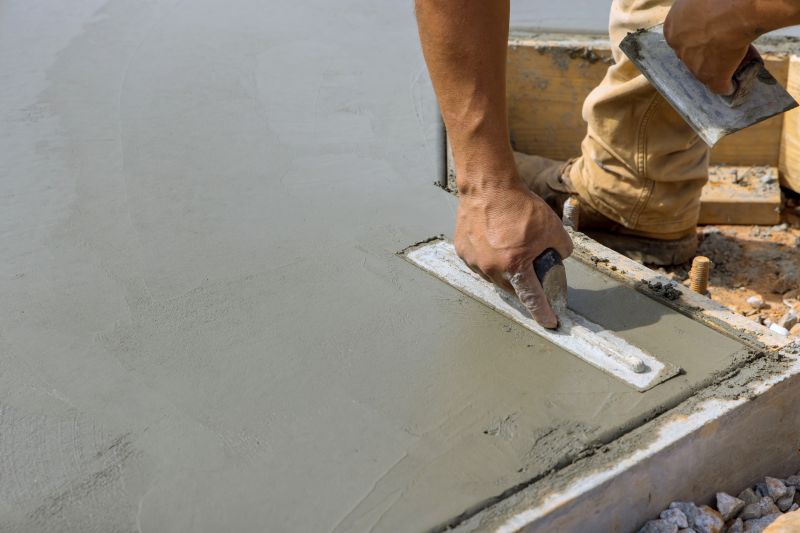Favorite Concrete Resurfacing Products For Easy Surface Upgrades
Select popular tools and materials that simplify the process of renewing and beautifying your concrete surfaces.
 Concrete resurfacing products offer a versatile solution for revitalizing and restoring worn or damaged concrete surfaces. These products can be applied to driveways, patios, walkways, and floors to improve appearance and durability. Resurfacing options vary widely, ranging from thin overlays to thicker coatings that can conceal imperfections and provide a fresh, uniform look. Proper preparation and application are essential to achieve optimal results, including cleaning the surface thoroughly and ensuring it is free of debris, oil, or loose material.
Concrete resurfacing products offer a versatile solution for revitalizing and restoring worn or damaged concrete surfaces. These products can be applied to driveways, patios, walkways, and floors to improve appearance and durability. Resurfacing options vary widely, ranging from thin overlays to thicker coatings that can conceal imperfections and provide a fresh, uniform look. Proper preparation and application are essential to achieve optimal results, including cleaning the surface thoroughly and ensuring it is free of debris, oil, or loose material.
Top Overall Option
Polymer Concrete Overlay
Polymer concrete overlays are a popular choice for their strong adhesion and versatile finish options. They can be applied over existing concrete surfaces to provide a durable, customizable layer that resists cracking and staining. These overlays often come in various textures and colors, offering a wide range of aesthetic possibilities for residential and commercial projects.
Types of Products For Concrete Resurfacings
Acrylic Concrete Coatings
Acrylic coatings provide a flexible, weather-resistant surface suitable for various outdoor applications, offering color options and textured finishes.
Polyurethane Coatings
Polyurethane coatings are known for their high durability and chemical resistance, ideal for high-traffic areas.
Epoxy Resurfacing Systems
Epoxy systems create a hard, glossy surface that is resistant to stains and wear, often used in garages and industrial settings.
Stamped Concrete Overlay
Stamped overlays mimic the appearance of brick, stone, or tile, adding decorative appeal to concrete surfaces.
Polymer Modified Concrete
These mixes incorporate polymers for enhanced bonding and flexibility, suitable for repairs and overlays.
Quartz Aggregate Coatings
Quartz coatings add texture and slip resistance, with a sparkling finish for aesthetic enhancement.
Self-Leveling Resurfacing Compounds
Self-leveling products are ideal for creating smooth, flat surfaces over uneven concrete.
Polyaspartic Coatings
Polyaspartic coatings cure quickly and provide UV stability, suitable for large outdoor areas.
Liquid Cementitious Overlays
These overlays are thin, cement-based layers that can be colored and textured for decorative purposes.
Resinous Floor Coatings
Resinous coatings offer seamless, durable surfaces often used in commercial or industrial settings.
Popular Choices
Acrylic resurfacers are favored for their ease of application and weather resistance, suitable for outdoor surfaces.
Epoxy coatings are commonly used to achieve a glossy, durable finish in garages and commercial spaces.
Stamped overlays are popular for decorative concrete projects, providing textured, patterned finishes.
Polyurethane sealers are often applied as a topcoat to enhance durability and appearance.
Quartz finishes are trending for their textured, slip-resistant surface with a sparkling appearance.
Self-leveling overlays are popular for creating smooth, flat surfaces over uneven concrete.
Polyaspartic coatings are gaining popularity for their fast curing and UV stability.
Liquid cement overlays are used frequently for decorative and repair purposes due to their versatility.
Resinous coatings are favored for their seamless, high-performance surfaces in industrial settings.
Decorative paints are popular for adding color and style to concrete surfaces with ease.
Many resurfacing products are formulated to adhere well to existing concrete, providing a durable layer that resists cracking and chipping over time. Some options include textured finishes to mimic natural stone or decorative patterns, allowing for customization based on aesthetic preferences. Additionally, there are products designed to enhance slip resistance, making surfaces safer in wet conditions. When selecting a concrete resurfacing product, it is important to consider the specific needs of the project, such as the level of surface damage, desired appearance, and environmental exposure.
Application techniques can vary from simple brush or roller methods to more complex spray systems, depending on the product type. Proper curing time and environmental conditions during application can influence the longevity and appearance of the resurfaced concrete. Regular maintenance, including cleaning and resealing when necessary, can extend the lifespan of the resurfacing layer. Whether for minor repairs or complete surface upgrades, choosing the right product can help achieve a professional-looking finish that enhances the overall value and safety of the area.
Key Buying Considerations
- Determine the specific surface conditions and choose a product suitable for repairs or decorative finishes.
- Consider the level of foot or vehicle traffic the surface will endure to select an appropriate durability rating.
- Evaluate the weather conditions during application, ensuring the product is compatible with temperature and humidity levels.
- Check compatibility with existing concrete surfaces to ensure proper adhesion and performance.
- Decide on the desired aesthetic, such as textured, smooth, or patterned finishes, and select products accordingly.
- Review curing times and application methods to match your project timeline and skill level.
- Assess slip resistance features if the surface will be exposed to water or outdoor elements.
- Look into maintenance requirements and long-term upkeep to maintain appearance and safety.
- Consider whether a primer or bonding agent is necessary for optimal adhesion.
- Evaluate the environmental exposure, including chemical spills or stains, to select the most resistant product.
- Choose products that offer flexibility or crack resistance if the surface is prone to movement.
- Review manufacturer instructions and technical data sheets for proper application procedures.
- Determine if a color or decorative finish is desired, and select products that offer a broad palette.
- Factor in budget constraints while balancing quality and longevity of the resurfacing solution.
- Ensure the product is suitable for the thickness and type of existing concrete surface.
